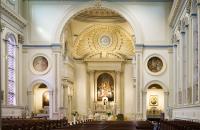After a tooooo long absence from writing in my blog, I’ve decided to ask my readers a question. How do you deal with seemingly impossible situations when you are traveling?
Do you scream at the other driver(s)? Do you give them one-fingered salutes? Do you get right up on their back bumper and intimidate them? Do you listen to traffic reports hoping to miss the latest fender-bender? Do you say insane things like, ‘There had better be blood or a body on the road to justify this kind of backup!’? Come on – it’s embarrassing to admit, but we’ve all been there.
So, who do we ask to intercede for us when travelling? Looks like the patron saint for this activity is St. Christopher. St. Chris has a lot of bases covered; athletes, ferrymen, lightning, pestilence, archers, bachelors, boatmen, bookbinders, epilepsy, floods, fruit dealers, fullers, gardeners, for a holy death, market carriers, motorists and drivers, sailors (same as a mariner, I would assume), storms, surfers, toothache, mountaineering, and transportation workers as well as things related to travel and travelers. Busy Saint!
His story seems a bit fantastic. He was supposedly a 7′ 6″ Canaanite. (I guess he could have been that tall – some people are. Wasn’t Samson and Goliath guys from Canaan too? Must be some ‘BIG’ genes in the Middle East!) From what I read in Wikipedia, he seemed a bit of a lost individual, like he couldn’t find his path in life. Sound familiar to anyone? I know I was looking for a good long time too. http://en.wikipedia.org/wiki/Saint_Christopher While Jesus didn’t actually sit on my shoulders like in the story of St. Christopher, he was there euphemistically and yes, the load was heavy until I saw the truth. Jesus says His burden is light, but yeesh!, the road to get there is terribly long and up-hill. I have to admit though, the view from the top is amazing! 🙂
So I get the picture. Traffic isn’t forever. You eventually reach your destination. You may have a couple more wrinkles or gray hairs, but all-in-all, you’re still in good health. I’m still saying the Rosary in traffic and many times in church on Sunday. I think I’ll be asking St. Christopher to pray the Rosary with me on those especially trying traffic days too.
I hope each of you have a light and easy journey to your next destination wherever that may be. And remember to take along St. Christopher and your Rosary. With a team like that, how can you go wrong!!!
Blessings,
Deneen











